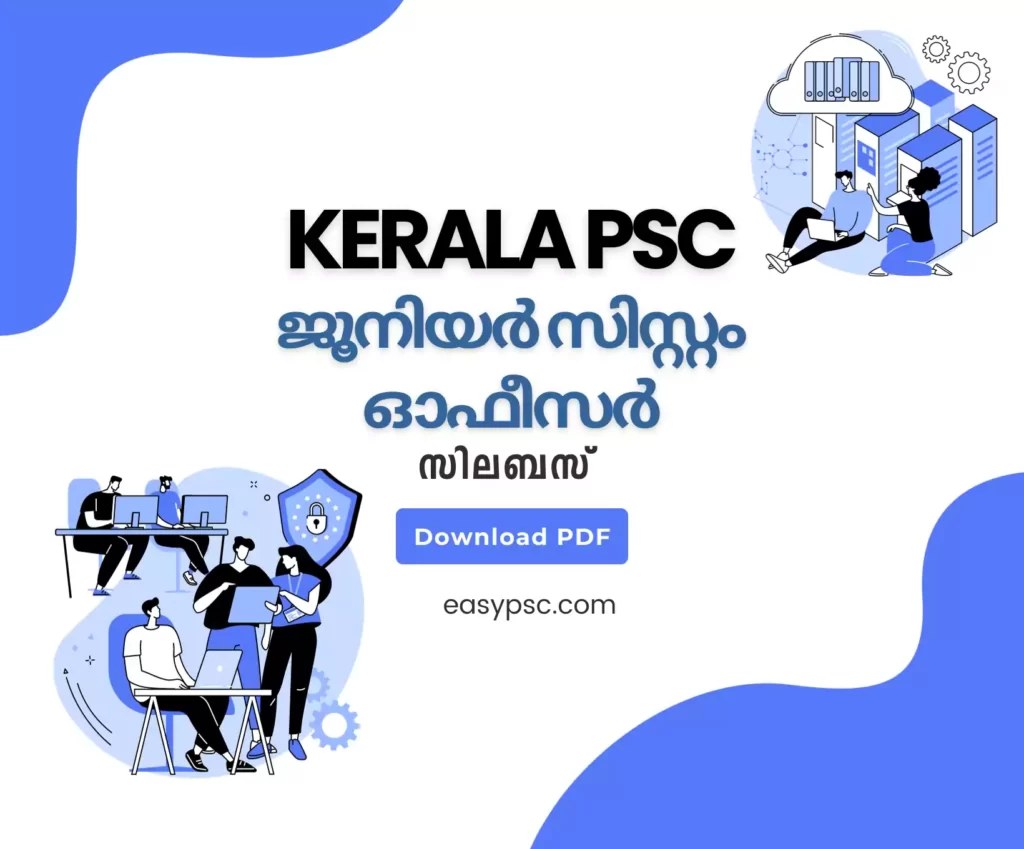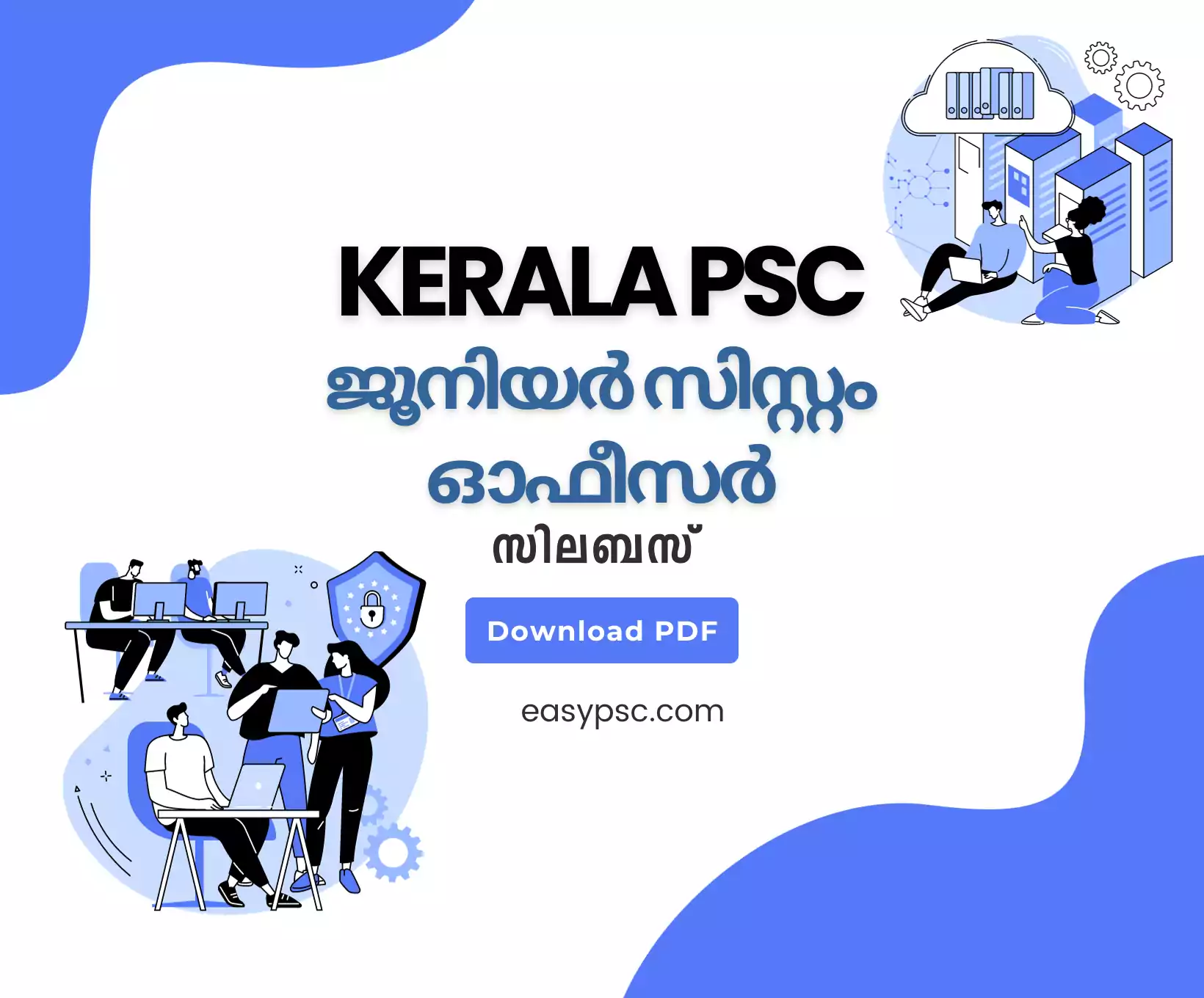
കേരള PSC ജൂനിയർ സിസ്റ്റം ഓഫീസർ സിലബസ്: കേരള PSC 31 ജനുവരി 2024 ന് നടത്തുന്ന കേരള കോ-ഓപ്പറേറ്റീവ് മിൽക്ക് മാർക്കെറ്റിംഗ് ഫെഡറേഷൻ ലിമിറ്റഡിലേക്കുള്ള ജൂനിയർ സിസ്റ്റം ഓഫീസർ [Junior Systems Officer] പരീക്ഷയുടെ വിശദമായ സിലബസും പരീക്ഷാ പാറ്റേണും ഇവിടെ നിന്നും PDF രൂപത്തിൽ ഡൗൺലോഡ് ചെയ്യാം. 31-01-2024 ബുധനാഴ്ച രാവിലെ 07:15 മുതൽ 09:15 വരെയാണ് പരീക്ഷാ സമയം. 100 മാർക്കിന്റെ OMR പരീക്ഷയാണ് വരുന്നത്. കൺഫോർമേഷൻ നൽകിയ സമയത്ത് സെലക്ട് ചെയ്ത ഭാഷയിലായിരിക്കും ചോദ്യ പേപ്പർ ലഭിക്കുക. ഇംഗ്ലീഷ് ഭാഷയിരിക്കും ചോദ്യ പേപ്പർ ഉണ്ടാക്കുക. 17-01-2024 മുതൽ അഡ്മിഷൻ ടിക്കറ്റ് കേരള PSC യുടെ വൺ ടൈം പ്രൊഫൈൽ വഴി ഡൗൺലോഡ് ചെയ്യുവാൻ സാധിക്കും. ആകെ 10656 പേരാണ് ഈ പരീക്ഷ എഴുതുവാൻ വേണ്ടി കൺഫോർമേഷൻ കൊടുത്തിരിക്കുന്നത്.
കേരള PSC ജൂനിയർ സിസ്റ്റം ഓഫീസർ സിലബസ് – പ്രധാന വിവരങ്ങൾ
താഴെ കൊടുത്തിരിക്കുന്ന പട്ടികയിൽ നിന്നും കേരള PSC യുടെ ജൂനിയർ സിസ്റ്റം ഓഫീസർ സിലബസിനെ പറ്റിയുള്ള എല്ലാ പ്രധാനപ്പെട്ട വിവരങ്ങളും ലഭിക്കുന്നതാണ്.
| പരീക്ഷ നടത്തുന്ന ഓർഗനൈസേഷൻ | കേരള പബ്ലിക് സർവീസ് കമ്മീഷൻ (KPSC) |
| കാറ്റഗറി | സിലബസ് |
| പരീക്ഷയുടെ പേര് | ജൂനിയർ സിസ്റ്റം ഓഫീസർ |
| വകുപ്പ് | കേരള കോ-ഓപ്പറേറ്റീവ് മിൽക്ക് മാർക്കെറ്റിംഗ് ഫെഡറേഷൻ ലിമിറ്റഡ് |
| കാറ്റഗറി നംബർ | 690/2022 |
| വിഷയം | കേരള PSC ജൂനിയർ സിസ്റ്റം ഓഫീസർ സിലബസ് |
| പരീക്ഷ തിയ്യതിയും സമയവും | 31/01/2024 ബുധൻ 07.15 am to 09.15 am |
| അഡ്മിഷൻ ടിക്കറ്റ് ലഭ്യമാകുന്ന തിയ്യതി | 17/01/2024 |
| ആകെ പരീക്ഷ എഴുതുന്നവർ | 10656 |
| ഒഫീഷ്യൽ വെബ്സൈറ്റ് | www.keralapsc.gov.in |
കേരള PSC ജൂനിയർ സിസ്റ്റം ഓഫീസർ സിലബസ് – മാർക്ക് ഡിസ്ട്രിബ്യൂഷൻ
കേരള PSC ജൂനിയർ സിസ്റ്റം ഓഫീസർ പരീക്ഷയുടെ മാർക്ക് ഡിസ്ട്രിബ്യൂഷൻ ഒന്ന് നോക്കാം. അതായത് ഓരോ ഭാഗത്ത് നിന്നും ലഭിക്കുന്ന മാർക്കിന്റെ വിവരങ്ങൾ. ഇത് മനസിലാക്കിയാൽ ഏത് ഭാഗത്തിന് കൂടുതൽ പ്രാധാന്യം കൊടുക്കണം, ഏത് ഭാഗം കൂടുതൽ ആഴത്തിൽ പഠിക്കണം എന്നൊക്കെ മനസിലാക്കാൻ സാധിക്കും.
| PART I | |
| Mathematics | 15 Marks |
| PART II | |
| Statistics | 15 Marks |
| PART III | |
| Physics | 15 Marks |
| PART IV | |
| COMMERCE | 15 Marks |
| PART V | |
| COMPUTER APPLICATION | 40 Marks |
| Total | 100 |
കേരള PSC ജൂനിയർ സിസ്റ്റം ഓഫീസർ സിലബസ് – വിശദമായ സിലബസ്
കേരള PSC ജൂനിയർ സിസ്റ്റം ഓഫീസർ പരീക്ഷയുടെ വിശദമായ സിലബസ് താഴെ നിങ്ങൾക്ക് കാണാവുന്നതാണ്. ഓരോ വിഷയങ്ങളും ഏത് ഭാഗത്ത് നിന്നും വരുന്നു എന്ന് കണ്ടെത്തി ചിട്ടയായ ഒരു പഠന രീതി ഉണ്ടാക്കിയെടുക്കുക. സിലബസും എക്സാമിന് ബാക്കിയുള്ള സമയവും വെച്ച് കൃത്യമായ ഒരു സ്റ്റഡി പ്ലാനും ടൈം ടേബിളും ഉണ്ടാക്കിയെടുക്കുക. കൃത്യമായി പഠിക്കുക. റാങ്ക് ലിസ്റ്റിൽ ഉയർന്ന ഒരു റാങ്ക് തന്നെ കരസ്ഥമാക്കുക. ഉടനെ ഒരു സർക്കാർ ജോലി എന്ന നിങ്ങളുടെ സ്വപ്നം നിറവേറ്റുക.
PART 1 – Mathematics – (15 Marks)
Module 1: Linear Algebra
Matrix – multiplication – determinants – transpose – symmetric matrix – Hermitian matrix – rank – characteristic roots Cayley’s theorem (2 Marks)
Module 2: Complex numbers
Basic definitions-basic operations with complex numbers and imaginary part – polar form of a complex number products- quotients – powers – modulus – roots of complex number- n th root of unity (3 Mark)
Module 3: – Analytic Geometry
distance formula – straight line – angle between lines – general second-degree equation to represent circle – ellipse – parabola- hyperbola- polar coordinate – cylindrical coordinate – spherical coordinates. (2 Mark)
Module 4: Calculus
limit of a function – indeterminate form – L’Hospital’s rule – continuous function – derivatives – increasing and decreasing function – critical points – stationary points – maxima and minima – concave up and concave down – point of inflections (2 Mark)
Module 5: First-Order Differential Equation
Order – degree – separable equation – linear equation – exact equation – homogeneous equation with constant coefficients. (2 Mark)
Module 6: Vector calculus
Position vector of a point – magnitude – dot product – projection of vector – angle between vectors – cross product – scalar triple products – gradient – divergent – curl- solenoidal vector – irrotational vector. (2 Marks)
Module 7: Abstract Algebra
Group – properties, examples – subgroup- cyclic groups – Permutations – rings – integral domains – ideals – fields. (2 Marks)
PART- II Statistics (15 Marks)
Module 1: Descriptive Statistics (3 Marks)
Scales of measurement, Different types of Data, Primary Data, and Secondary Data, Types of Probability Sampling – Simple Random Sampling, Stratified Random Sampling, Systematic Sampling, Classification and Tabulation, Frequency Distribution, Measures of Central Tendency, Measures of Dispersion, Raw and Central Moments, Skewness, Kurtosis, Correlation, Regression.
Module 2: Probability (6 Marks)
Random Experiments, Events, Definitions of Probability, Elementary Probability Theory, Problems based on Classical Definition of Probability, Conditional Probability, Bayes Theorem, Random Variables, Standard Probability Distributions such as Poisson, Binomial and Normal Distributions.
Module 3: Inferential Statistics (6 Marks)
Population and Sample, Sampling Distributions, Statistics, Statistical Estimation, Desirable Properties of Estimators, Statistical Testing of Hypothesis, Tests Based on and Statistics.
PART- III Physics ( 15 Marks)
Module 1. Properties of Matter (4 marks)
Elasticity-Modulus of elasticity, the three elastic moduli, Surface tension-shapes of drops, concept of excess of pressure, capillary rise, variation of surface tension with temperature, Fluid Dynamics- Streamline and turbulent flow, equation of continuity, Bernoulli’s theorem and its applications, Viscosity- coefficient of viscosity, Stoke’s formula, variation of viscosity with temperature.
Module 2. Thermal Physics (3 marks)
Thermal conductivity, coefficient of thermal conductivity, Weidman-Franz law, Radiation of heat, Stefan’s law, Zeroth Law and First law of Thermodynamics, differential form of first law, different thermodynamic processes, specific heat capacities, Carnot’s heat engine, entropy
Module 3. Optics (3 marks)
Interference of light- The principle of superposition, coherent sources, Double slit interference, interference in thin films, Newton’s Rings, DiffractionFresnel diffraction, Half-period zones, Fraunhofer diffraction-diffraction at a single slit, diffraction grating, LASER-Basic principle, He-Ne laser, optical fiber- step, index fiber, graded index fiber, numerical aperture.
Module 4. Modern Physics (5 marks)
Black body radiation curve, photoelectric effect, Compton effect, Bohr model- hydrogen atom, wave nature of particles, uncertainty principle, wave function, Vector atom model-quantum numbers associated with vector atom model, L-S and J-J couplings, Zeeman effect, Anomalous Zeeman effect, Paschen-Back effect, Stark effect, Solids-Amorphous and Crystalline Materials, Unit Cell, Types of Lattices, Miller Indices, Nucleus-Constituents of nucleus and their intrinsic properties, binding energy, Nuclear fission and nuclear fusion processes.
PART IV – COMMERCE (15 Marks)
Module 1. Basic Accounting
Accounting process- Accounting Terms- debtor, creditor, current and non-current assets and liabilities – Accounting Vs bookkeeping revenue vs. capital income and expenditure – Cash system vs accrual system- Double entry vs single entry – Journal – Special journal – Ledger – Trial balance – Components of GAAP- Annual financial statements- Analysis of annual financial statements – Accounting ratios – Comparative statements. (5 marks)
Module 2. Banking
Lending policies – Principles of sound lending – Lending criteria – Loan management- appraisal, monitoring – Forms of Lending- cash credit, overdraft, term loans – Secured and unsecured advances – Modes of charging security- lien, mortgage, hypothecation, pledge, assignment – Primary security and collateral security – Standard asset and non-standard asset, Nonperforming assets – Provision for bad and doubtful assets. (5 marks)
Module 3. Co-Operation
Formation of Co-operative society – Fundamental documents of a society – Important legislations regulate a society- Cooperative principles – Structure of cooperative societies – Administration of a society – Sources of finance of a society – Utilisation of finance of a societyDistribution of earnings – Important books and accounts maintained by a Society. (5 marks)
PART V – COMPUTER APPLICATION (40 Marks)
Module I. Computer Fundamentals (10 Marks)
Computer Hardware and Software, Input/ Output devices, Generation of Computers, and Computer Systems: Micros, Minis, and Main-frames, Memory Units: RAM, ROM, Secondary Storage Devices, Cache Memory, and Virtual Memory.
Module II. Programming in C (10 Marks)
Tokens, Data types, Operators, Control Statements, User defined functions, Arrays, Pointers, Structure and Union, and File operations.
Data Structures: Concept of Data Structures, Types of Data Structures: Linear, Non-linear, Data Structure Operations, An Introduction to Stacks, Queues, Linked Lists, Trees, and Graphs.
Module III. Operating Systems (10 Marks)
Structure of Operating Systems, Operating System Functions, Distributed Systems, The Process, Process State, PCB, Threads, Process Scheduling Basic Concepts, Scheduling Criteria.
Database Management Systems: Introduction to Database System applications, Database design, Data Models: Hierarchical Model, Network Model, Entity Relationship Model, Object Oriented Data Model, Relational Model, Set Operations.
Module IV. Computer Networks and Security (10 Marks)
Use of Computer Networks, Network Topologies, Types of Networks – LAN, WAN, MAN, Data Communication – Data Flow, Data transmission mode – Simplex, Half Duplex, Full Duplex, Modem, Router, Switch, Internet Service Providers, Search Tools.
Artificial Intelligence: Overview of an AI, Definition and Importance of Knowledge, Knowledge-Based Systems, Representation of Knowledge, Natural Language Processing Introduction, Overview of Linguistics, Grammar and Languages, Basic Parsing Techniques, Natural Language Systems.
NOTE: – It may be noted that apart from the topics detailed above, questions from other topics prescribed for the educational qualification of the post may also appear in the question paper. There is no undertaking that all the topics above may be covered in the question paper.
കേരള PSC ജൂനിയർ സിസ്റ്റം ഓഫീസർ സിലബസ് – PDF ഡൗൺലോഡ് ചെയ്യാം
കേരള PSC ജൂനിയർ സിസ്റ്റം ഓഫീസർ പരീക്ഷയുടെ വിശദമായ സിലബസ് കേരള PSC യുടെ ഔദ്യോഗിക വെബ്സൈറ്റിൽ പ്രസിദ്ധീകരിച്ചു. താഴെ കൊടുത്തിരിക്കുന്ന ലിങ്കിൽ നിന്നും ജൂനിയർ സിസ്റ്റം ഓഫീസർ പരീക്ഷയുടെ സിലബസ് PDF ഡൗൺലോഡ് ചെയ്ത് എടുക്കാം.







